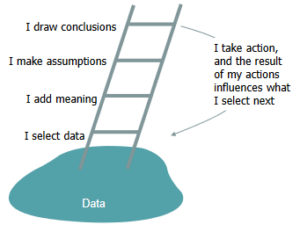Park Perspective: The Power of Curiosity in Conflict Management
By Ashley Hamilton, MBA ’24

Ashley Hamilton, MBA '24, canoeing in the Adirondacks with classmate
The term “conflict” generally carries a negative connotation as conflicts are often seen as obstacles to accomplishing tasks or goals; but they can be learning or improvement opportunities. Similar to how pain is a cautionary sign to the human body when something is amiss, conflict is an alert that some element of the group is out of sync beyond normal margins. During my first semester at Johnson, I quickly learned that curiosity is a foundational element of conflict management and below I will detail a strategy to help hone your leadership curiosity.
The case to consider curiosity over judgment
Our brains are biologically set up to process a vast amount of information flooding in from our senses in mere seconds to aid us in making decisions. While this feat is commendable, it often leads us to make quick judgements that can incorporate our biases and result in under-baked conclusions. Prior to coming to Johnson, I had heard of the Ladder of Inference model, but I had never fully internalized it. It was not until a pre-term lecture, where we dove into the theory and its applications, that I realized how dangerous the cyclical nature of my unconscious snap judgements could be in influencing how I navigate the world and interact with others, especially in a conflict.
The Ladder of Inference, a model developed by organizational psychologist Chris Argyris and organizational researcher Peter Senge, illustrates how our brains often process information (see image). The ladder represents our mental processes when crafting an internal narrative to decide on an action. At the base of the ladder is a “pool” of data of all the information you know about a person or a situation. As you “climb the ladder,” each rung represents the evolution of the decision process:
- I select data: You draw data from the pool and narrow it down to a few data points.
- I add meaning: You assign meaning to each of those selected data points.
- I make assumptions: Using information from the previous rungs, you formulate assumptions about the person or situation.
- I draw conclusions: You wed all the information to generate an internal narrative/conclusion.

The ladder is quite cyclical: Your conclusions influence the actions you take, which in turn influence the data you select the next time you make a related decision. The mental processes shown in the ladder of inference occur within seconds; if you are defaulting to judgement instead of curiosity, it can skew your conclusions and actions.
A strategy to choose curiosity
Pivoting your default to curiosity versus judgement requires a perspective change from a knowing mindset to a learning mindset. With a knowing mindset, you assume you understand things and draw conclusions without seeking further information through inquiry. With a learning mindset, you approach each situation with an open mind and ask questions to glean more information.
A learning mindset will not manifest overnight; it will require you to work towards reframing your mental processes. In Professor Allan Filipowicz’s Leading Teams course, he discusses three main factors that drive human behavior:
- A person’s character – e.g., brave, lazy, etc.
- Social influence – e.g., culture, upbringing, instruction from another person, etc.
- Situational/environmental influence – e.g., tired, hungry, hot, etc.
When you default to judgement, you are often only making one guess to explain another person’s behavior. To shift towards curiosity, it is crucial to try to come up with two to three guesses about what is driving a person’s behavior and to ensure that the guesses are coming from the different driver categories.
As I was learning about this concept during pre-term, I realized I had an immediate opportunity to test this strategy. Earlier that week, one of my teammate’s had shown up 20 minutes late to a team meeting and, unconsciously, I had made the snap guess that he arrived late because he did not care about the project. In retrospect, as I reflected on the pool of data I knew about him and employed Professor Filipowicz’s two to three guesses strategy, it dawned on me that of course there were many reasons he could have been late. A few I came up with were: 1. His past workplace culture was more lenient on meeting start times. 2. During the summer, Ithaca’s public transit runs less frequently and he could have been delayed in waiting for a bus.
Generating guesses from different behavior driver categories encourages you to approach the situation with curiosity. If you use just one category to generate multiple guesses about another’s behavior, it can sometimes show your conscious or unconscious bias towards that person. In my personal experience, using this technique to pivot to choosing curiosity not only improved my relationships with others but it also helped me redirect my energy and diffused my frustration. That, in turn, minimized the mental drain of needing to suppress my emotions when interacting with someone I might previously have judged.
Conclusion
There are many avenues to conflict management but one of the most powerful tools is to approach a situation with curiosity. Choosing curiosity over judgement takes practice and vulnerability but becomes easier with consistent practice and will make you a better leader. Additionally, your curiosity in the face of conflict stands to help you and your teams unlock unrealized potential.
About Ashley Hamilton, MBA ’24

Ashley Hamilton is a first-year MBA candidate in the Two-Year MBA program at the Samuel Curtis Johnson Graduate School of Management. Before business school, she worked as a program manager at the Chicago Jobs Council, a nonprofit committed to ending poverty through access to quality employment. Within the capacity building team, she oversaw the Frontline Focus Training Institute that provided professional development opportunities for social workers to connect clients to employment. She holds a BBA in marketing and a BA in psychology from Pace University.
